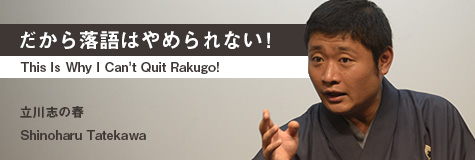
6. Performing a Winter "Ninjo" Story in the Land of Eternal Summer
Shinoharu Tatekawa
How is everyone doing in this heat?
We are now in the middle of summer. Rakugo performers wear silk gauze kimonos during the summertime, but we are still quite hot. Even though the fabric is almost transparent and looks quite cool, when you put on a haori coat we wear on top, it comes to four layers, or actually I should say five layers when you count an extra layer of meat that chubby guys like myself tend to carry around, and that becomes a bit too much.
Long live the metabolism! And a thousand praises for the washable kimono!
I recently visited an even hotter place: a land of eternal summer near the equator, Singapore. It was not that I stopped caring about the heat. I have been performing rakugo in Singapore once every six months and this was actually the seventh time.
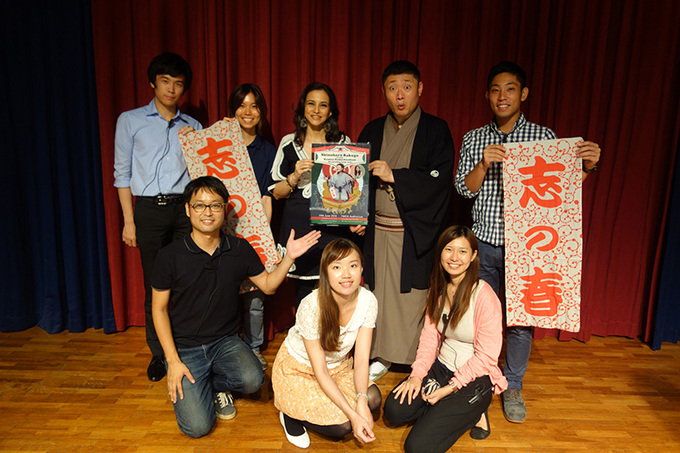
With the local event company staff at my English rakugo show in Singapore on June 19
My secret theme for this show was to blend in more in Singapore, so I got a haircut at a local barber before my show. My grandfather always said that "to blend in with the locals, get your haircut at a local barber!"
With that in mind, I went to the Indian neighborhood where there are said to be full of barber shops. Incidentally, I was told that the barbers of Singapore do not sweep up hair clippings off the floor. The reason is, apparently, that the amount of hair on the floor demonstrates the number of customers who visit, saying in a sense that "we get tons of business!" So it is a kind of advertisement.
I therefore decided to try and find the shop with the most hair on the floor. That turned out to be a shop that also had the perfect name, "Super Star Haircuts." Let me tell you, there was lots of hair on that floor. And, as it was in the Indian neighborhood, most of the customers were Indian, so the power of that hair on the floor was something else entirely. It was not silky at all.
So I sat down and said, "Please cut it in the most popular hairstyle in Singapore," and they were done in a jiffy. It cost me six Singapore dollars and they gave me a short side part style. Believing that I could now blend in, I looked down to see my own hair blending in with all that powerful hair.
It had a significant effect. After having the haircut, everyone stopped talking to me in Japanese completely, even when shopping in town. They also stopped speaking to me in English as well. In fact, the language everyone spoke to me was 100% Chinese. Putting aside the question of whether or not I was actually blending in, I was able to have the day of my show with a good feeling.
Actually, this time I had planned an English rakugo performance for the locals, an English rakugo performance to celebrate the 100th anniversary of the Japanese Association, Singapore, and a Japanese rakugo performance at an izakaya. The first among those was the English performance for the locals. In that show, I had decided to try two new experiments.
The first was to try collaborating with a local storyteller. I invited Kamini Ramachandran, a wonderful storyteller I had met three years before at the International Story Telling Festival in Singapore, to join me. Each of us perform a story on a shared theme of "married couples," and had a conversation with her on the stage in-between.
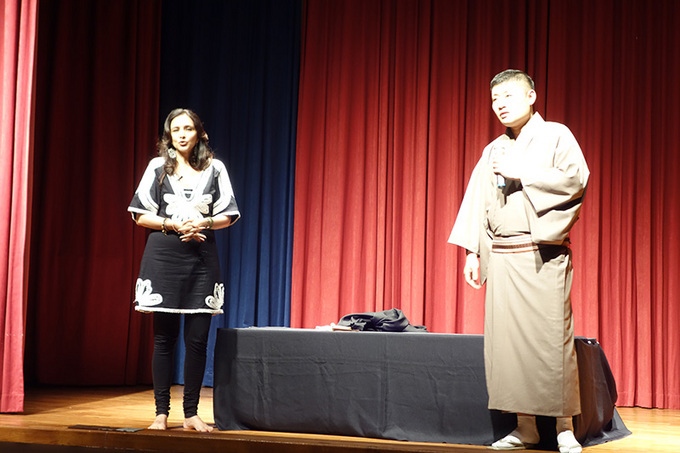
Talking with Kamini Ramachandran, a storyteller from Singapore.
The second experiment was to do a ninjo-banashi (a story about people's hearts, emotions, humanity, or kindness). I had previously done Yabuiri, a gentle story about a father and child, in English, so this time I decided to try Shibahama, which is the epitome of a ninjo-banashi.
Let me give you a quick summary.
One morning, a fish dealer, who was a drunkard and lazy, discovered a leather wallet on the beach containing a great amount of money. He showed it to his wife and said, "Now I don't have to work anymore, I can just drink all day!" Overwhelmed with joy, he invited his friends to a big party and eventually fell asleep drunk. His wife became quite worried when she saw this, and you'll never guess the lie she told to help him reform, nor will you guess the surprising outcome.
So, yes, this is a story of a married couple. The story evokes a scene of a cold morning near the end of the year, so in Japan, or, well, only in Japan obviously, it is a story frequently performed at the end of the year. So my mission for this performance was to find out for myself just how much the feelings of an extremely typical Japanese couple would be understood in tropical Singapore.
I performed Shibahama right after doing Chiritotechin. I was nervous for the first time in a long while.
And the result is...they got it!
After saying the punchline, I was greeted with a different type of applause from what I had previously experienced, and this explains me that ninjo-banashi can be understood here as well. Obviously, the reaction of the audience was different from what would be typical from that of Japanese audience. There was a bit more laughter than usual at the funny bits. They were completely silent when the story called for it, and they held their breath in the suspenseful parts. Some people were even crying, so I felt sure that we had shared the same emotions.
It encouraged me to polish these stories even more and do them in many different places.
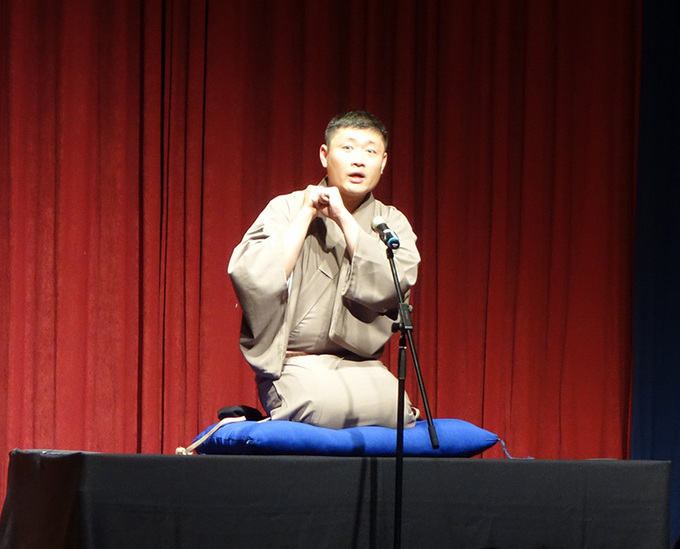
Performing Shibahama, a ninjo-banashi set in winter, while wiping off sweat in the tropical country
I suspect that the scene of the cold winter morning might not have been adequately presented by myself, dripping with sweat as I was. They probably did not get the atmosphere of the married couple quietly listening to bell tolls on the New Year's Eve.
But I think there is more meaning in counting what can be understood, rather than what cannot be done. I perform rakugo in English because I want to bridge the gap between Japanese people who do not think it will be understood by non-Japanese-speakers, and non-Japanese who think they will never understand it because they do not speak Japanese.
All I can do is devote myself to spreading the parts which can be understood. So for now I shall do that in Japanese first!
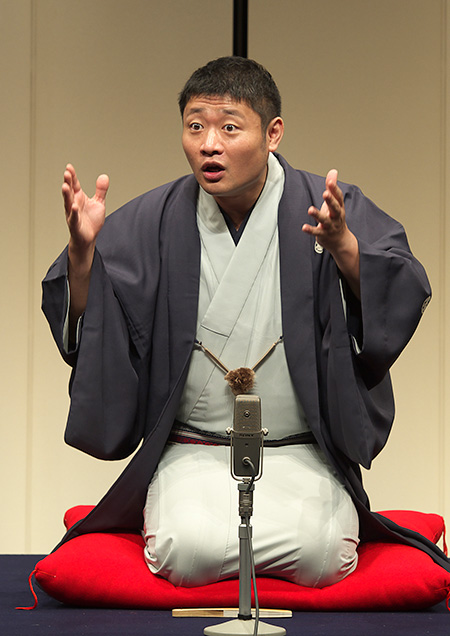 Shinoharu Tatekawa
Shinoharu Tatekawa
Rakugo performer Shinoharu Tatekawa was born in Osaka in 1976 and raised in Kashiwa, Chiba Prefecture. After graduating from Yale University in the U. S., he began working at Mitsui & Co. in 1999. In his third year of work, he chanced upon a performance by Shinosuke Tatekawa. It had such a huge impact on him that he made the decision to become a rakugo performer after half a year, upon much deliberation. He approached Shinosuke Tatekawa directly to accept him as a disciple, but was rejected. However, he then resigned from his job and entreated the master once again to accept him as a disciple. In October 2002, he was accepted as the third disciple of Shinosuke Tatekawa. In January 2011, he was promoted to futatsume (the second highest rank). He performs classical and contemporary rakugo works, as well as rakugo in English, and has even performed in Singapore. In 2013, he received an encouragement prize from the Nikkan Tobikiri Rakugo Kai. His publications include Dare demo waraeru eigo rakugo (Rakugo in English; Shinchosha) and Anata no purezen ni "makura" wa aruka? Rakugo ni manabu shigoto no hinto (Does your presentation have an "introduction"?; Star Seas Company). His latest publication is Jibun wo Kowasu Yuki (Courage to destroy yourself: CrossMedia Publishing).
*Please visit the official websites below for information about his live performances.
Shinoharu Tatekawa's official website http://shinoharu.com/
Shinoharu Tatekawa's blog http://ameblo.jp/tatekawashinoharu/
Back Issues
- 2022.7.27 Beyond Disasters - T…
- 2022.6.20 Beyond Disasters - T…
- 2021.6. 7 Contributed Article …
- 2021.4.28 Crossing Borders, En…
- 2021.4.27 Contributed Article …
- 2021.4.20 Contributed Article …
- 2021.3.29 Contributed Article …
- 2020.12.22 Interview with the R…
- 2020.12.21 Interview with the R…
- 2020.11.13 Interview with the R…

